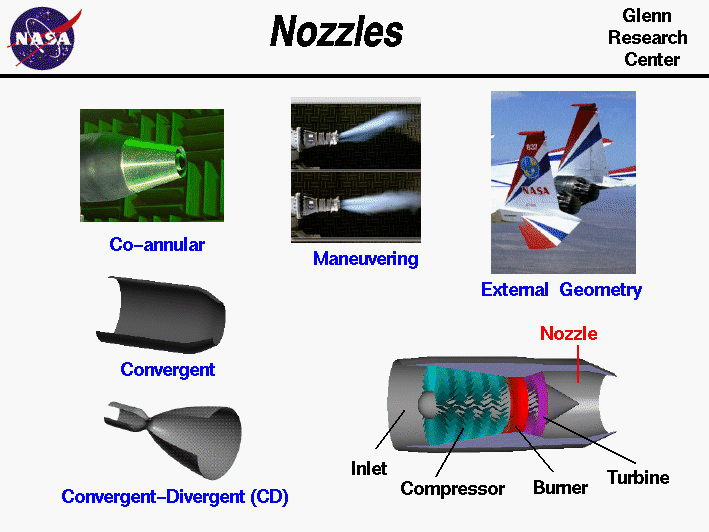
|
This page is intended for college, high school, or middle school students.
For younger students, a simpler explanation of the information on this page is
available on the
Kids Page.
|

Most modern passenger and military aircraft are powered by
gas turbine engines, which are also called
jet engines. There are several different types
of gas turbine engines, but all turbine engines have some parts
in common. All gas turbine engines have a nozzle to produce
thrust, to conduct the exhaust gases back
to the free stream, and to set the mass
flow rate through the engine. The nozzle sits downstream of the
power turbine.
A nozzle is a relatively simple device, just a specially shaped
tube through which hot gases flow. However, the mathematics
which describe the operation of the nozzle takes some careful
thought. As shown above, nozzles come in a variety of shapes and
sizes depending on the mission of the aircraft.
Simple turbojets,
and turboprops, often have a fixed
geometry convergent nozzle as shown on the left of the figure.
Turbofan engines often employ a
co-annular nozzle as shown at the top left. The core flow exits
the center nozzle while the fan flow exits the annular nozzle.
Mixing of the two flows provides some thrust enhancement and these
nozzles also tend to be quieter than convergent nozzles.
Afterburning turbojets and turbofans
require a variable geometry
convergent-divergent - CD
nozzle as shown on the left.
In this nozzle, the flow first converges down to the
minimum area
or throat, then is expanded through the
divergent section to the exit at the right.
The flow is subsonic upstream of the throat, but
supersonic downstream of the throat.
The variable geometry causes these nozzles to be heavier than a fixed geometry nozzle,
but variable geometry provides efficient engine operation over a wider airflow range than a simple fixed nozzle.
Rocket engines also use nozzles to
accelerate hot exhaust to produce thrust.
Rocket engines usually have a fixed
geometry CD nozzle with a much larger divergent section than is
required for a gas turbine.
You can explore the design and operation of nozzles with
our interactive
nozzle simulator
program which runs on your browser.
All of the nozzles we have discussed thus
far are round tubes. Recently, however, engineers have been
experimenting with nozzles with rectangular exits. This allows the
exhaust flow to be easily deflected, or
vectored,
as shown in the middle of the
figure. Changing the direction of the thrust with the nozzle makes
the aircraft much more maneuverable.
Because the nozzle conducts the hot exhaust back to the free
stream, there can be serious interactions between the engine exhaust
flow and the airflow around the aircraft. On fighter aircraft, in
particular, large drag penalties can occur near the nozzle exits. A
typical nozzle-afterbody configuration is shown in the upper
right for an F-15 with experimental maneuvering nozzles. As with the
inlet design, the external nozzle
configuration is often designed by the airframer and subjected to
wind tunnel testing
to determine the performance effects on the airframe.
The internal nozzle
is usually the responsibility of the engine manufacturer.
Activities:

Guided Tours
-
 Parts of a Jet Engine:
Parts of a Jet Engine:

-
 Nozzle:
Nozzle:

-
 Turbojets:
Turbojets:

-
 Afterburning Turbojets:
Afterburning Turbojets:

-
 Turbofans:
Turbofans:

-
 Ramjets:
Ramjets:

-
 Rockets:
Rockets:

-
 Model Rocket Engines:
Model Rocket Engines:

-
 Nozzle Simulator:
Nozzle Simulator:

Navigation ..





- Beginner's Guide Home Page
|
